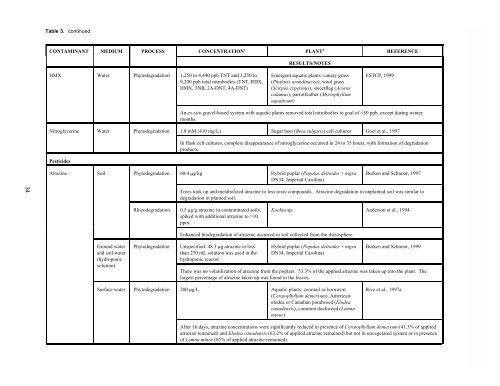Ground Water Issue Phytoremediation of Contaminated ... - CLU-IN
Ground Water Issue Phytoremediation of Contaminated ... - CLU-IN
Ground Water Issue Phytoremediation of Contaminated ... - CLU-IN
Create successful ePaper yourself
Turn your PDF publications into a flip-book with our unique Google optimized e-Paper software.
34<br />
Table 3. continued<br />
CONTAM<strong>IN</strong>ANT MEDIUM PROCESS CONCENTRATION 1<br />
HMX <strong>Water</strong> Phytodegradation 1,250 to 4,440 ppb TNT and 3,250 to<br />
9,200 ppb total nitrobodies (TNT, RDX,<br />
HMX, TNB, 2A-DNT, 4A-DNT)<br />
PLANT 2<br />
RESULTS/NOTES<br />
Emergent aquatic plants: canary grass<br />
(Phalaris arundinacea), wool grass<br />
(Scirpus cyperinus), sweetflag (Acorus<br />
calamus), parrotfeather (Myriophyllum<br />
aquaticum)<br />
ESTCP, 1999<br />
REFERENCE<br />
An ex-situ gravel-based system with aquatic plants removed total nitrobodies to goal <strong>of</strong> 10<br />
ppm.<br />
Kochia sp. Anderson et al., 1994<br />
Enhanced biodegradation <strong>of</strong> atrazine occurred in soil collected from the rhizosphere.<br />
Phytodegradation Unspecified: 48.3 g atrazine in less<br />
than 270 mL solution was used in the<br />
hydroponic reactor.<br />
Hybrid poplar (Populus deltoides × nigra<br />
DN34, Imperial Carolina)<br />
Burken and Schnoor, 1999<br />
There was no volatilization <strong>of</strong> atrazine from the poplars. 53.3% <strong>of</strong> the applied atrazine was taken up into the plant. The<br />
largest percentage <strong>of</strong> atrazine taken up was found in the leaves.<br />
Surface water Phytodegradation 200 g/L Aquatic plants: coontail or hornwort<br />
(Ceratophyllum demersum), American<br />
elodea or Canadian pondweed (Elodea<br />
canadensis), common duckweed (Lemna<br />
minor)<br />
Rice et al., 1997a<br />
After 16 days, atrazine concentrations were significantly reduced in presence <strong>of</strong> Ceratophyllum demersum (41.3% <strong>of</strong> applied<br />
atrazine remained) and Elodea canadensis (63.2% <strong>of</strong> applied atrazine remained) but not in unvegetated system or in presence<br />
<strong>of</strong> Lemna minor (85% <strong>of</strong> applied atrazine remained).
















